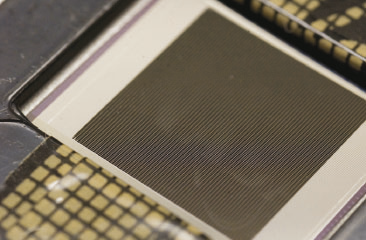THE CENTERPIECE OF THE JWST IS A NEAR INFRARED SPECTROMETER, one of many new instruments invented for the telescope. The spectrometer will focus on the faint glow of faraway galaxies by utilizing a waffle-like grid of microshutters. Each waffle cell is covered by a microshutter measuring 100 by 200 microns, or the width of several human hairs. There are altogether more than a quarter-million microshutters or cells.
Each microshutter can be opened or closed individually, enabling the telescope to view — and block out — selected portions of the sky. The microshutter opens with the application of a magnet and closes when the magnet is removed.
To receive weak infrared light signals from selected points at the edge of the universe, some microshutters must remain open for days at a time. In these cases, a 40-volt electrostatic charge will be applied to “latch” the microshutter to the cell wall and prevent it from closing after the magnet is removed.
This prolonged opening, however, can cause the microshutter to lock in the open position after the applied voltage is withdrawn. The problem, called “stiction,” causes NASA to lose control over the microshutters.
To solve stiction, NASA turned to James Hwang, director of Lehigh’s Compound Semiconductor Technology Lab. Hwang has modeled the movement of dielectric charges in MEMS (microelectromechanical systems) and explored methods of minimizing the accumulation of those charges.
Working with three undergraduate electrical engineering majors, Hwang discovered the reason for the stiction — the voltage applied to keep the microshutter lid open was causing dielectric charge to be trapped in the cell’s silicon-nitride insulator.
“When you hold the microshutter open for several days at a time, charge starts to build up in the insulator,” says Hwang. “Normally, to close the microshutter, you remove the voltage and it springs shut. But a charge that is trapped in the insulator is sufficient to keep the microshutter open.
“We established that the dielectric charging can cause stiction. We cannot say that all stiction occurs because of the dielectric charging, but we believe that a majority of it can be attributed to the charging.”
Hwang and his students recommend using a bipolar voltage, opening the microshutter with alternating applications of positive and negative voltages and thus canceling the trapping of the charge in the silicon-nitride insulator.
NASA engineers have come up with two other potential solutions to the stiction problem. One involves placing ribs on the cell wall to which the microshutter latches when opened; this would minimize the contact area between shutter and wall, thus reducing charging and stiction. The other solution is to apply a hydrophobic coating to the microshutter surface. The three solutions are not mutually exclusive, says Hwang, and can be used in concert to minimize stiction.
Rob Guzzon, Andy Melchior and John Yamrick, the undergraduates who investigated the stiction problem, traveled to Maryland to use GSFC’s cryogenic testing equipment. Guzzon is now a Ph.D. student at the University of California-Santa Barbara. Melchior works for Thales, the international electronics and systems group, on a MEMS project related to software-defined radio. Yamrick is completing a second B.S. at Lehigh, this one in engineering physics.
“I relied heavily on all three students,” says Hwang, who also supervises six Ph.D. candidates and four postdoctoral researchers. “Even though they were undergraduate students, they were ready to take on independent research and be treated like Ph.D. students.

